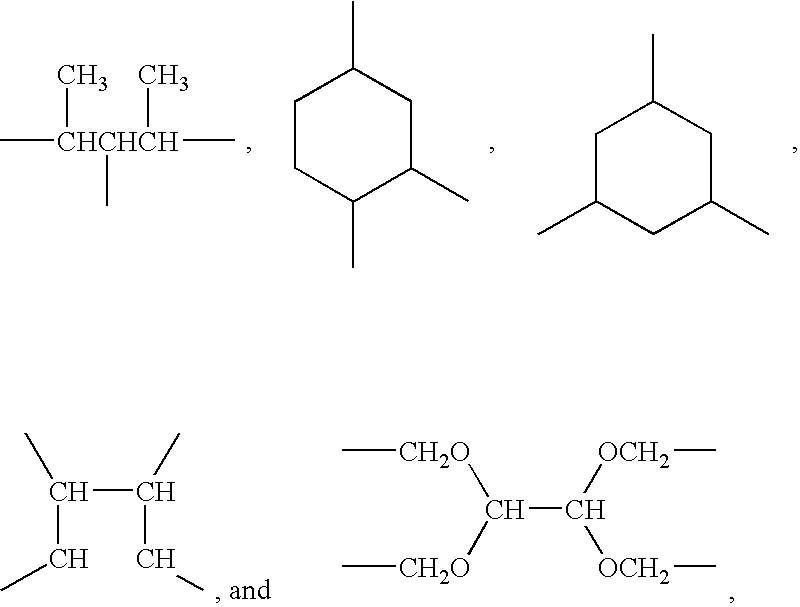Alkenyl-functional siloxane copolymers as antimisting additives for silicone coating compositions
a technology of antimisting additives and siloxane, which is applied in the direction of coatings, other chemical processes, thin material processing, etc., can solve the problems of spray mist formation, and achieve the effect of improving antimisting effect and improving antimisting
- Summary
- Abstract
- Description
- Claims
- Application Information
AI Technical Summary
Benefits of technology
Problems solved by technology
Method used
Image
Examples
example 1
[0114]A total of 162 g of 1,2,4-trivinylcyclohexane, in which a 1% strength by weight (based on elemental platinum) solution of a platinum-1,3-divinyl-1,1,3,3-tetramethyldisiloxane complex in an α,ω-divinyldimethylpolysiloxane having a viscosity of 1000 mPa·s at 25° C., a catalyst solution known as the Karstedt catalyst (whose preparation is described in U.S. Pat. No. 3,775,452) has been dissolved, so that the solution contains 40 ppm platinum, are slowly metered into 503 g of 1,1,3,3-tetramethyldisiloxane which has been heated to 50° C. After the end of metering, reaction is allowed to continue at 80° C. and a C═C conversion (1H-NMR) of more than 99% is achieved. Excess disiloxane is removed by distillation, giving a hydrosiloxane polymer having a viscosity of 60 mm2 / s (25° C.) and an Si-bonded hydrogen content (active hydrogen content) of 0.43% by weight.
[0115]At 25° C., 50 g of this intermediate are mixed homogeneously into 3120 g of an α,ω-divinyldimethylpolysiloxane having a ch...
example 2
[0116]A mixture of 90.2 g of 1,2,4-trivinylcyclohexane and 1869 g of an α,ω-dihydrodimethylpolysiloxane having an active hydrogen content of 0.214% by weight is activated at 25° C. by adding 0.34 g of a Karstedt catalyst solution with a platinum content of 1% by weight (as described in Example 1). A temperature rise to 70° C. within a few minutes indicates onset of hydrosilylation, which achieves more than 99% conversion after 15 minutes. The branched siloxane polymer with SiH end groups has an active hydrogen content of 1.19 meq / g and a viscosity of 27 mm2 / s (25° C.).
[0117]In order to prepare a branched vinyl polymer, 126 g of the above-obtained SiH-functional polymer are mixed with ˜392 g of an α,ω-divinyldimethylpolysiloxane having a vinyl content of 0.67 meq / g and the mixture is heated to 47° C. The addition of 10 ppm platinum in the form of the Karstedt catalyst solution (as described in Example 1) leads to an immediate temperature increase to 68° C., and after 30 minutes to a ...
example 3
[0118]The procedure of Example 2 is repeated with the modification that instead of the 392 g of an α,ω-divinyldimethylpolysiloxane having a vinyl content of 0.67 meq / g, 1089 g of the α,ω-divinyldimethylpolysiloxane having a chain length of 100 Si atoms (Si100) are used. This gives a branched vinyl polymer having a viscosity of 7510 mm2 / s (25° C.) and a vinyl content of only 0.12 meq / g as a clear, colorless oil.
PUM
| Property | Measurement | Unit |
|---|---|---|
| speeds | aaaaa | aaaaa |
| viscosity | aaaaa | aaaaa |
| viscosity | aaaaa | aaaaa |
Abstract
Description
Claims
Application Information
 Login to View More
Login to View More - R&D
- Intellectual Property
- Life Sciences
- Materials
- Tech Scout
- Unparalleled Data Quality
- Higher Quality Content
- 60% Fewer Hallucinations
Browse by: Latest US Patents, China's latest patents, Technical Efficacy Thesaurus, Application Domain, Technology Topic, Popular Technical Reports.
© 2025 PatSnap. All rights reserved.Legal|Privacy policy|Modern Slavery Act Transparency Statement|Sitemap|About US| Contact US: help@patsnap.com



